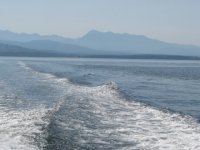Jay - sorry I'm not privy to any data comparing seaworthiness of CDs to other
boats. I have not knocked this feature in CDs only to mention I wished they (all?)
had self draining cockpits.
Harvey - I agree the laws of physics always apply, at least to any situation I can
imagine. I do not agree with your supposition that 2 liquids (H2O: salt, fresh)
with different densities show the same physical properties; wind induced
wave characteristics, behavior of surface vessels and buoyancy, etc.
For your enjoyment , and for those who recognize large (say 30' - 60') waves
, and for those who recognize large (say 30' - 60') waves
and how a few different vessels respond in those conditions, kindly regard the
below link. Without too much stretch in the imagination, I can see a C-Dory
behaving a little less favorably at more modest speeds than the little yellow one.
NB: this computer depiction shows ocean waves and swells unlike the Great Lakes.
https://www.youtube.com/watch?v=trus6OWFCpQ
Aye.
boats. I have not knocked this feature in CDs only to mention I wished they (all?)
had self draining cockpits.
Harvey - I agree the laws of physics always apply, at least to any situation I can
imagine. I do not agree with your supposition that 2 liquids (H2O: salt, fresh)
with different densities show the same physical properties; wind induced
wave characteristics, behavior of surface vessels and buoyancy, etc.
For your enjoyment
and how a few different vessels respond in those conditions, kindly regard the
below link. Without too much stretch in the imagination, I can see a C-Dory
behaving a little less favorably at more modest speeds than the little yellow one.
NB: this computer depiction shows ocean waves and swells unlike the Great Lakes.
https://www.youtube.com/watch?v=trus6OWFCpQ
Aye.

